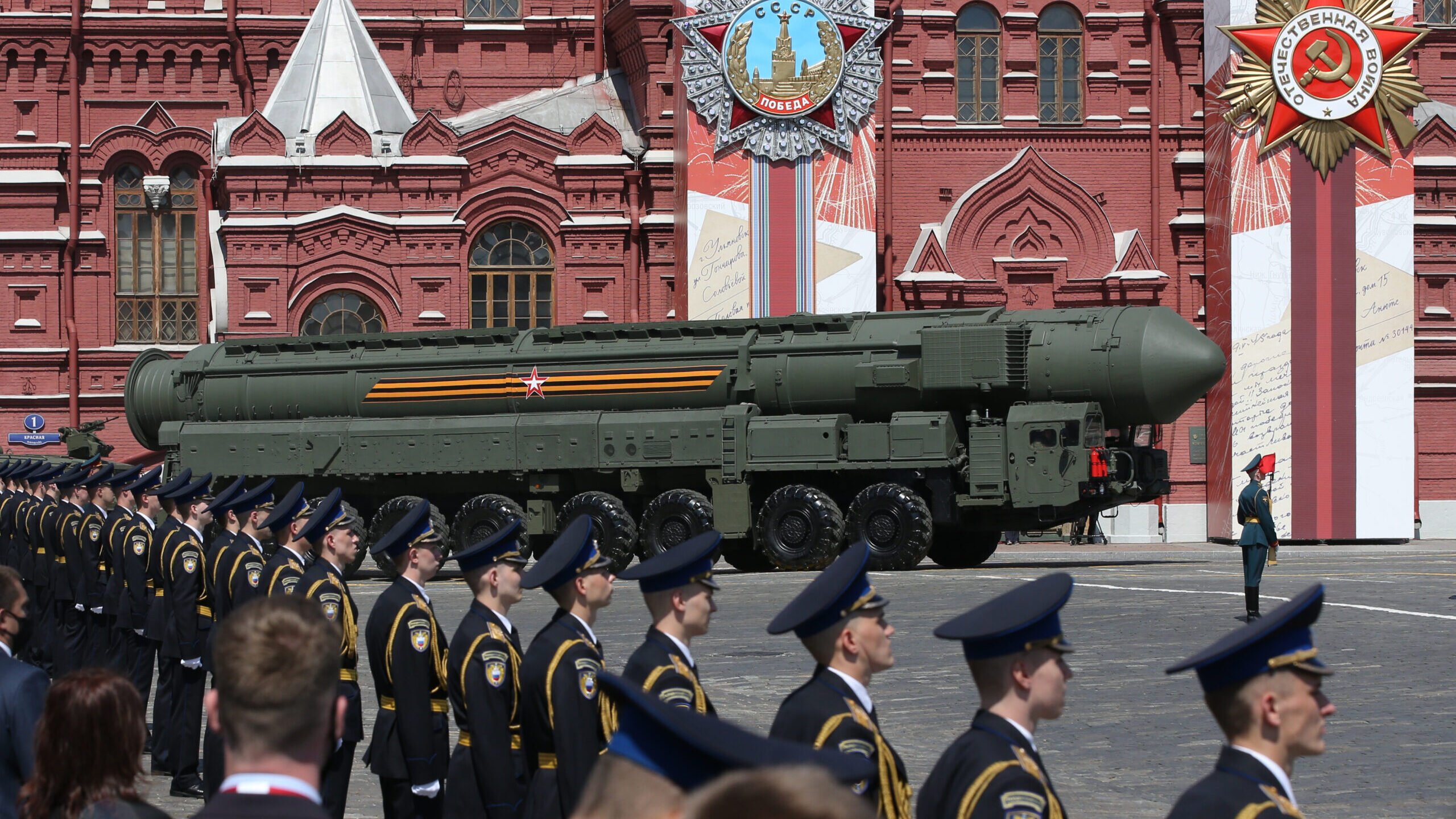
Russian nuclear missile rolls along Red Square during the military parade marking the 75th anniversary of Nazi defeat, on June 24, 2020 in Moscow, Russia. (Photo by Mikhail Svetlov/Getty Images)
SMD 2020 — US Strategic Command is “furiously” rewriting its deterrence theory to account for a tripolar nuclear power world — the political equivalent of trying to solve the infamous “three body problem” in physics, according to the command’s top official.
“The global security environment is now today a three-party nuclear peer reality where the PRC [the People’s Republic of China] and Russia are stressing and undermining the rules-based international order,” Strategic Command head Adm. Charles Richard told the annual Space and Missile Defense Symposium in Huntsville, Ala. “I’m not sure what strategic stability looks like in a three-party world.”
Richard explained that today’s deterrence does not look like the Cold War, where both superpowers could rely heavily on “passive” measures to constrain destabilizing actions and maintain the nuclear balance via mutually assured destruction.
“[T]here are many passively stable two body orbital regimes that you can stick stuff in, but there are exactly zero passively stable three body orbital regimes. They all require active stabilization. And I don’t even know what that means when the forces can’t be described by physics but are political, so we have gotten to think through this much harder than we have in the past,” he said.
As Richard indicated, in physics the three body problem refers to the inherent difficulty in predicting the effect three bodies in space will have on each other. (It is also the name of an award-winning sci-fi novel by Chinese writer Liu Cixin that used the problem as a central plot device.)
What is clear, he said, is that traditional concepts such as the nuclear deterrence escalation “ladder” no longer work. Therefore, US leaders need to come up with a much more “dynamic” concept of deterrence, one that takes into account both the nuclear and conventional domains, as well as the use of other tools besides military prowess.
“We can start by rewriting deterrence theory,” Richard said. “I’ll tell you, we’re furiously doing that out of STRATCOM. We’ve got some better two-party stuff — it’s actually working quite well in the current crisis [with Russia] — that is radically different: non-linearity, linkages, chaotic behavior, inability to predict — all attributes, that are just don’t show up in classic deterrence theory.”
But, he said, more effort needs to be made to figure out how to handle the unprecedented “three-party problem” of a tripolar nuclear relationship. “We have never faced two peer nuclear capable opponents at the same time who have to be deterred differently,” he stressed.
Richard applauded Secretary of Defense Lloyd Austin’s “integrated deterrence” concept as going in the right direction, noting it allows the Pentagon “to think about the problem holistically and then integrate across functions, theaters, domains and the spectrum of conflict.”
However, he cautioned that implementing integrated deterrence remains a work in progress for the Defense Department.
“We’re building an operational framework for integrated deterrence. We’ve made some tremendous strides. But there’s a lot more work we have to do. We need an integrated deterrence strategy that adapts our strategic capabilities, capacity and posture to keep changing pace with the evolving global threats,” he stressed.
In the near term, Richard said his top priority is missile warning.
“We need new missile defenses starting with missile warning. That’s the number one thing I need, missile warning, so I know what to do on how to posture and dispose my forces,” he said. “It’s due to these rapidly expanding and evolving threats: hypersonic weapons, cruise missiles potentially with intercontinental range, unmanned aerial systems, proliferation of shorter range ballistic missiles, and several novel weapon systems.”
As an example of the latter, Richard mentioned China’s test last year of a fractional orbital bombardment (FOBS) system using a hypersonic glide vehicle — an emerging capability “never before seen in the world.”
“I am not convinced at all we’ve fully thought through the implications of what that weapon system means,” he added. “You’re gonna get decreased warning timelines, difficulties in attribution, and an increased threat to our traditional space and missile defenses and forces.”
To deal with these new threats, as well as the increasing use of missile in conflict (exemplified by Russia’s use of missiles with dual nuclear and conventional capabilities), Richard called for a revamp of US missile defense posture.
“We’ve got to look harder at dispersal, hardening, redundancy, mobility to complicate opponent attack plans, reduce the confidence of attack success, raise the threshold for potential conflict, and give our senior leaders more decisions faced by limiting damage from attacks,” he said.
Second, he said, DoD needs to move faster to develop new capabilities “left of launch” including better early warning and/or improved understanding of when early warning simply isn’t going to be available.
“We absolutely have to have responsive, persistent, resilient and cost-effective joint integrated missile defense sensor capabilities, integrated command and control, new sensor architecture, and launch impact tracking on these threats,” he explained.
Third, Richard called for “active and passive defenses against regional hypersonics.”
And finally, he said, a new posture must also concentrate more “on missile defeat, not just active missile defense,” and do so in a way that is “based on a top-down architecture that synchronizes US allied and partner country contributions and capabilities.”






















